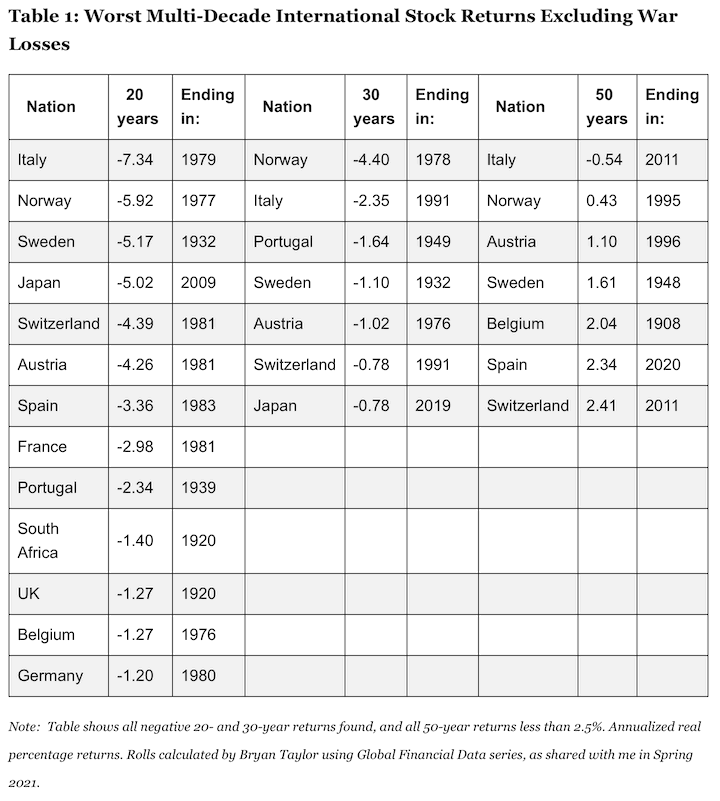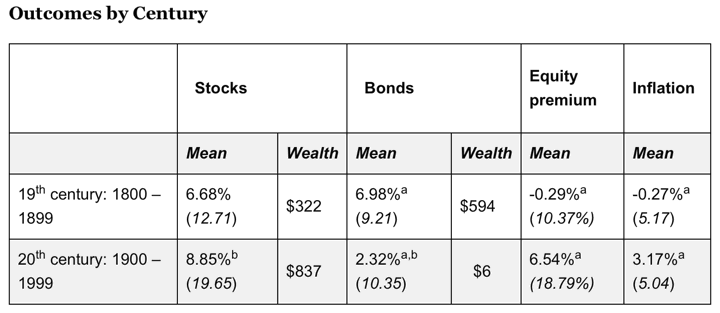
Professor Edward McQuarrie has recently published the final part in his 3-part series about long-term stock returns at the CFA Institute:
- Don’t Bank on the Equity Risk Premium
- What Price Risk? Unpacking the Equity Risk Premium (Part 2)
- Stocks for the Long Run? Setting the Record Straight (Part 3)
He spends a lot of time fighting back against other people putting words in his mouth, so I’ll try to be extra careful in my own interpretation of his articles.
“One country, one century”. If you look at the returns of the S&P 500 from 1926-2024, as is the widely-available dataset, then yes, US stocks look pretty great for the long run. But this is “one country, one century”. If you look at other countries and other centuries, the returns can look different.
Countries other than the US. If you look at other countries, you will find multiple historical examples of negative average returns even over a 20-year period.

19th century US returns. If you stay with US stocks but change the century, you’ll also discover different results. In the 1800s, the long-term average returns between stocks and bonds were much closer, with bonds even winning by a hair:

I don’t know if this wider set of data will make anyone change their minds, but perhaps it’ll add a little more context to the argument.
To be clear, McQuarrie still states that owning a good chunk of stocks remains the best bet available. It’s not just a sure thing. At the minimum, consider the possibility that the difference in future returns between stocks and bonds may not be as wide as in the past 10-20 years.
Because stocks remain risky regardless of the holding period, stocks often outperform, because investors get compensated for taking that risk. Stocks are a good wager over the long term, on favorable odds. But stocks remain a bet, one that can go bad for any randomly selected investor over their personal time horizon.
 The Best Credit Card Bonus Offers – 2025
The Best Credit Card Bonus Offers – 2025 Big List of Free Stocks from Brokerage Apps
Big List of Free Stocks from Brokerage Apps Best Interest Rates on Cash - 2025
Best Interest Rates on Cash - 2025 Free Credit Scores x 3 + Free Credit Monitoring
Free Credit Scores x 3 + Free Credit Monitoring Best No Fee 0% APR Balance Transfer Offers
Best No Fee 0% APR Balance Transfer Offers Little-Known Cellular Data Plans That Can Save Big Money
Little-Known Cellular Data Plans That Can Save Big Money How To Haggle Your Cable or Direct TV Bill
How To Haggle Your Cable or Direct TV Bill Big List of Free Consumer Data Reports (Credit, Rent, Work)
Big List of Free Consumer Data Reports (Credit, Rent, Work)
Jonathan,
This is a good update to the international equities post you did a couple of weeks ago. I still believe Intl stocks are not the way to go. The quote “one country, one century” is correct but for my age group, it should be updated to “one country, one lifetime”.
Fascinating. No wonder I lost money every time in any Norway equity purchase.